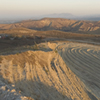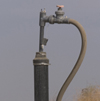Design The landfills are designed to allow disposal of non-hazardous solid wastes. Current permits require all disposal areas to be constructed with a composite liner system and leachate collection system. The leachate collection system gathers wastewater that is generated by the overlying municipal solid waste.
The landfills are designed to allow disposal of non-hazardous solid wastes. Current permits require all disposal areas to be constructed with a composite liner system and leachate collection system. The leachate collection system gathers wastewater that is generated by the overlying municipal solid waste.
The primary liner consists of a synthetic 60-mil-thick high-density polyethylene (HDPE). The primary liner is underlain by 2-ft of low permeability soil, or equivalent material. Together, these two components of the liner system prevent contaminants from penetrating the surrounding environment.
The leachate collection system consists of synthetic drainage material called a geocomposite. The geocomposite is comprised of high-density polyethylene channels manufactured to rapidly convey liquids such as leachate. It is considered to be an acceptable equivalent to one-foot of granular drainage material. A non-woven filter geotextile is attached to prevent infiltration of soil that will clog the geocomposite. Base grades are sloped to a central collection sump which is designed for subsequent removal of leachate to an onsite storage tank.
All areas of the liner system are protected by a 1.5 ft to 2 ft thick soil layer. The soil layer prevents the overlying waste from penetrating and damaging the liner system.
Following completion of the various liner components, landfill construction is accomplished by the area method. Open refuse is minimized by the construction of daily work areas sized to handle only each day's volume, and subsequently covered and sealed with soil or alternate daily cover (ADC) at the end of each day.
Groundwater Monitoring The current groundwater-monitoring program includes monitoring wells placed both upstream and downstream of active areas. The locations of the wells are principally selected to intercept groundwater that flows beneath the landfills. The depth of the monitoring wells have been selected to monitor the uppermost groundwater. Monitoring wells are sampled and inspected by an independent environmental monitoring laboratory on a regular basis in accordance with state and federal regulations and permits.
The current groundwater-monitoring program includes monitoring wells placed both upstream and downstream of active areas. The locations of the wells are principally selected to intercept groundwater that flows beneath the landfills. The depth of the monitoring wells have been selected to monitor the uppermost groundwater. Monitoring wells are sampled and inspected by an independent environmental monitoring laboratory on a regular basis in accordance with state and federal regulations and permits.
Landfill Gas Monitoring A regular gas-monitoring program is in place and includes permanent landfill gas probes located along the perimeter of the landfill. The probes are installed to monitor the entire depth of waste to ensure that methane gas does not migrate off the landfill property.
A regular gas-monitoring program is in place and includes permanent landfill gas probes located along the perimeter of the landfill. The probes are installed to monitor the entire depth of waste to ensure that methane gas does not migrate off the landfill property.
Landfill Gas Collection & Recovery
The landfill gas collection and recovery system was designed to achieve the following:
- Reduce the potential for off-site landfill gas migration
- Minimize landfill gas emissions from the surface of the landfill
- Control landfill odors
A landfill gas recovery system has been installed and is in operation at the landfills. The purpose of the system is to collect and incinerate methane gas that is generated by the decomposition of waste.
The gas recovery system is designed to provide continuous removal of landfill gas in active areas of the landfill and consists of gas extraction wells, gas collection piping, vacuum collection skid, and enclosed flare. Gas wells are installed at appropriate spacing to efficiently collect gas generated by the waste. The wells are connected to a pipe network that transmits gas to a high efficiency flare for destruction. A vacuum is applied to the gas well field by a blower system located adjacent to the flare, which pulls landfill gas through the pipe network and routes it to the flare.
